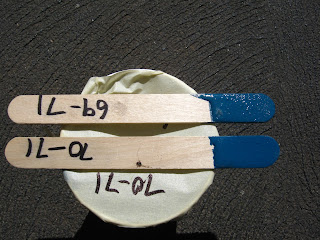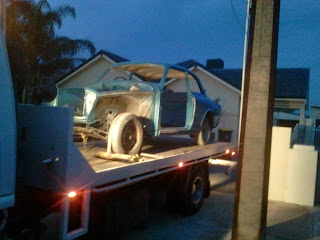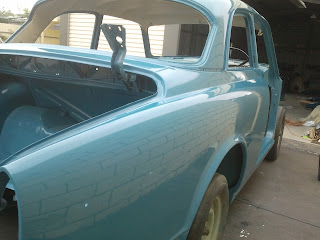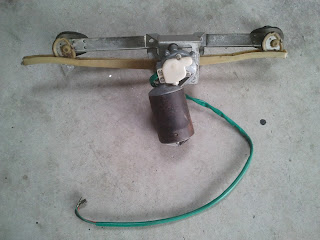Because I used acrylic primer the only topcoat I could use was acrylic lacquer. That's the same as the original paint they used in the factory in Sweden. The Volvo 122S left the factory without a clear coat back in the days, so a clear coat is not necessary. The Volvo colour code for the paint is 99 (medium blue). But watch out when you order it; there are to different solid colours with code 99 for the Volvo. My Volvo is from 1969 so I took the '69-'71
 |
| Two different colours coded 99 from Volvo |
I used paint (330 acrylic lacquer) and special acrylic thinner from protec. The mix ratio is 1 part paint - 1.5 part thinner. So to spray the car including the engine bay, boot and dash I needed around 6 litres acrylic and 9 litres thinner. I got all my paint, spray gun, compound etc. from
Lonsdale Paints. I liked this shop because those people know what there're talking about and always gave me professional info and very useful tips on how to paint.
I started with the inside of the bonnet and the boot to practice a bit. With acrylic lacquer you need to apply double header coats....A double header coat means
two coats of paint, the second coat sprayed immediately after the first with no flash time in between.
I applied 3 double header coats of the thinned acrylic lacquer, allowing a 5 minute flash off between coats.
 |
| Spray painted inside of the Volvo 122S bonnet |
The panels came out pretty good but after 10 minutes or so it was so misty in the booth that I couldn't see a thing...Not enough airflow and ventilation.
So I decided to spray only the interior and some smaller parts and bring the rest of the car to a prof spray painter.
 |
| Right side window in blue |
 |
| Dashboard Volvo 122S with new coat |
Craig started spraying all the panels.
 |
| Painted panels back in the shed |
Two weeks later the body got it's final coat.
 |
| Volvo back home |
 |
| 7 fresh coats of acrylic lacquer |
With Acrylic lacquer you'll always get some orange peel (the paint finish will look like the skin of an orange).
 |
| Close up orange skin - orange peel |
To get rid of the orange peel it needs to be wet sanded with 1200-1500-2000 grit followed by a buff with compound. That's why you have to put on 6-7 coats of paint; With the colour sanding, buffing and polishing you'll lose 2 coats.
Sanding with the 1200 grit will be the biggest job in the whole process because this is the part where you're sanding off all the orange peel. The 1500 and 2000 grit sanding sessions are necessary to get rid of the scratches caused by the 1200 grit.
I started sanding really careful and tried to avoid the edges of the panels. I used a soft rubber sanding block (it must have a similar softness as the mouse of your hand..) with a half sheet sand paper wrapped around it. It's really important to keep the panel you're sanding wet and to change your sandpaper regularly. If you use it too long you'll get nasty scratches caused by the build up debris in the paper. Listen carefully when sanding, if you hear a scratchy noise there's dirt between the paint and sand paper, stop sanding and clean before you continue! That's the only job I do without music.. I sanded the panels outside on the lawn because it's soft enough to put the panels on and all the water won't turn the shed into a swimming pool :)
 |
| Soft rubber sanding block |
The first panel I sanded looked ok imo so I gave it a nice buff with the machine and G3. But.... All I got was a shiny orange peel look.. It needed more sanding. After a while I knew what to watch for. If you see tiny glossy spots in the sanded surface this means there's still some orange peel and the paint needs more sanding.
 |
| Sanding Acrylic Lacquer - this panel needs more sanding |
 |
| Panel getting flat, almost ready to buff |
For the buffing I used Farécla G3 and a prof. buffing machine (Rupes) with a sheepskin pad which I could borrow from Craig.
 |
| Rupes Buffing machine and Farécla G3 compound |
 |
| Meguiars Cut'N Shine Sheep skin cutting pad |
This Rupes is a pretty heavy machine with a powerful 900Watt 1800 rpm motor. When using it it's own weight is almost enough to do the job so don't apply to much pressure. When you apply to much pressure you can easily burn the paint and it's way harder to control the machine; it will go in all different directions and it's much harder to keep it horizontal. Also keep it moving over the paint, never hold it on one spot for more than a second, the paint will get to hot and will burn (the build up heat will turn the paint in "rubber", see pic below). Luckily I could buff this burned spot out witch some G3..
 |
| Paint burned.. |
Avoid the edges when sanding and buffing... well uhmmm I forgot it for a second... hallo again primer. Luckily Acrylic is easy to touch up. After this and the burned paint I used the Rupes only for the bigger areas, smaller parts, corners etc can be done by hand which is a bit safer...
 |
| Sanded trough the acrylic... :( |
When using a sheep skin for buffing you'll get swirl marks in the paint. But with some Farécla G10 and a white soft foam pad on the Rupes you'll get rid of them. The best way to inspect your sanding, buffing and polishing is to check it under a fluorescent light. It will highlight all the scratches and little imperfections. If it looks ok inside then it will look perfect outside :) !!
 |
| Swirl marks caused by buffing with sheep skin |
 |
Farécla G10 and a white soft foam pad on the Rupes
|
 |
Polished Boot - now waiting for some wax
|
 |
| Roof sanded with 1200-1500-2000 grit before buffing with G3 |
 |
| Roof Volvo 122S after buffing with Farecla G3 |
 |
| Volvo 122S body shell after buffing with Farecla G3 and G10 |
 |
| Close up after buffing with foam pad and Farecla G10 |
Now the paint has to cure for a couple of weeks (normally around 4-8 weeks after painting) before I can apply the wax and Glaze. If you put wax on paint that's to fresh the wax will seal the paint and thus trapping the solvents that are still escaping the fresh paint. I some cases it can even cause the paint to lift... So I'm happy to wait a while. Still got lots of other jobs to do on the car.

































